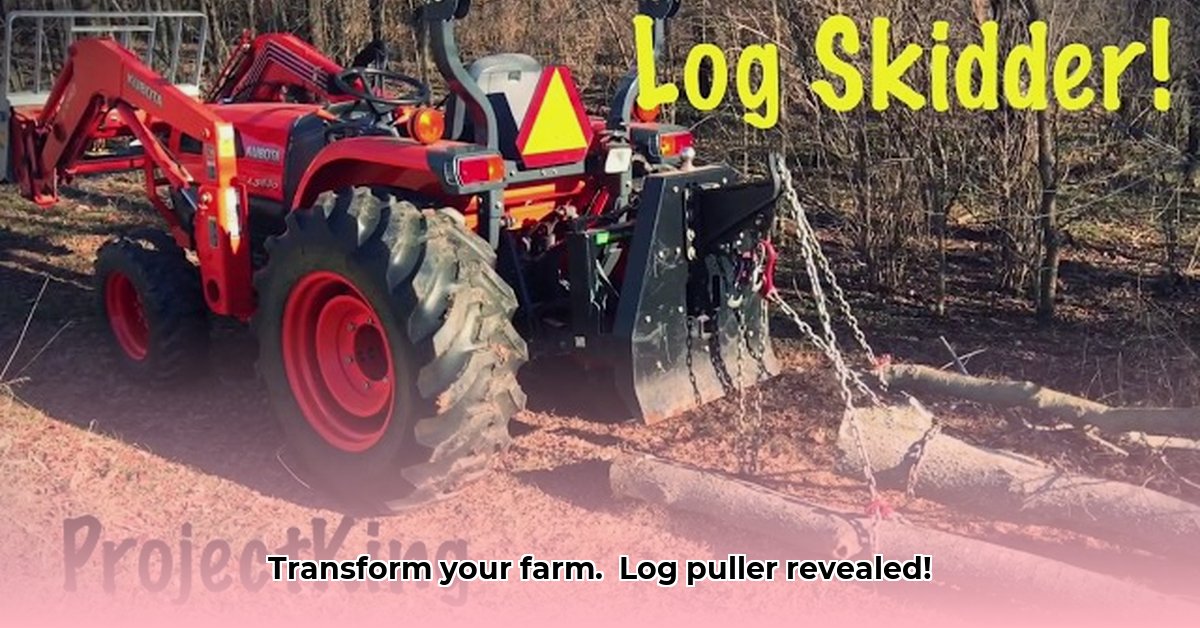
Log Pullers for Tractors: A Guide to Sustainable Logging
Modern farming demands efficiency and sustainability. If your operation involves timber harvesting, a tractor log puller can significantly boost productivity while minimizing environmental impact. This comprehensive guide helps you choose the right log puller for your farm, ensuring a smooth, efficient, and eco-conscious logging process. Isn't maximizing your yield while minimizing your environmental footprint a worthwhile goal? For other tractor attachments, check out tractor attachments.
Finding the Perfect Fit: Choosing Your Tractor Log Puller
Selecting the ideal log puller requires careful consideration of your specific needs. What size logs do you typically handle? Is your terrain flat or hilly? What's your budget? Answering these questions will guide your decision-making process. Think of it like choosing the right tool for a specific job – a small, lightweight model might suffice for smaller operations on flat land, while a larger, more robust model is needed for substantial logs and uneven terrain.
Key Factors to Consider
- Pulling Capacity: Measured in pounds or tons, this indicates the maximum weight the puller can handle. Always choose a capacity exceeding the heaviest logs you anticipate moving, incorporating a safety margin for unexpected challenges.
- Winch Type: Hydraulic winches offer smoother, more controlled pulling, while hand-crank winches are simpler but demand more manual labor. Consider your preference and the types of logs you'll be moving.
- Tractor Compatibility: Ensure the puller is compatible with your tractor's three-point hitch. A mismatched system poses significant safety risks.
Different Types of Tractor Log Pullers
Several log puller types cater to various needs and budgets.
- Three-Point Hitch Pullers: Directly attached to your tractor's three-point hitch, these offer stability and ease of use. They’re a popular choice for many farmers due to their straightforward design and reliable performance.
- Independent Winch Systems: These separate units offer greater flexibility, particularly on uneven terrain, allowing for precise log placement and maneuvering. This added maneuverability can be crucial in challenging environments.
- Skidders: While not strictly log pullers, skidders are often considered alongside them, especially for larger-scale operations. They’re designed for heavier-duty tasks and significant timber volumes.
Comparative Analysis: Fuel Efficiency, Cost, and Maintenance
Choosing the right log puller involves balancing cost, efficiency and maintenance requirements. The following illustrates the types of comparisons you should conduct:
| Feature | Model A | Model B | Model C | Considerations |
|---|---|---|---|---|
| Pulling Capacity | 8,000 lbs | 12,000 lbs | 15,000 lbs | Match capacity to your largest logs, plus a safety margin. |
| Winch Type | Hydraulic | Cable | Hydraulic | Hydraulic offers smoother control; cable is simpler but requires more effort. |
| Fuel Efficiency | Good | Fair | Excellent | Weigh initial costs against ongoing fuel expenses. |
| Maintenance Needs | Low | Moderate | Low | Consider potential repair costs and resulting downtime. |
| Approximate Price | $2,500 | $4,500 | $6,000 | Balance features and capabilities with your budget. |
Note: These are examples. Actual prices and features vary by brand and model.
Sustainability Considerations: Minimizing Environmental Impact
Sustainable forestry is paramount. Log pullers, when used correctly, can contribute to lower environmental impact. Their efficiency reduces the number of passes needed across the land, minimizing soil compaction and potential habitat disruption. However, responsible use is key. Avoid excessive pulling force and select routes minimizing disturbance.
A Step-by-Step Guide to Safe and Efficient Log Pulling
Prioritizing safety is non-negotiable. Follow these steps for safe and efficient operation:
- Pre-Operation Inspection: Thoroughly inspect the log puller for damage or loose parts before each use. Never operate a damaged machine.
- Secure the Log: Attach the winch cable securely; ensure proper wrapping and positioning to prevent slippage or breakage.
- Gradual Pulling: Begin slowly, gradually increasing power. Avoid sudden jerks or excessive tension.
- Mind the Terrain: Pay close attention to the terrain; adjust speed and technique to avoid obstacles.
- Safety Gear: Always wear appropriate safety gear: gloves, sturdy boots, and eye protection. Maintain safe distance from moving parts.
Conclusion: Optimizing Your Logging Operation
The right log puller is a valuable investment, boosting efficiency and sustainability. Careful consideration of your needs, coupled with safe operating practices, will ensure a more manageable and profitable logging operation. Remember to research various models, compare prices and features, and select the model best suited to your specific requirements.